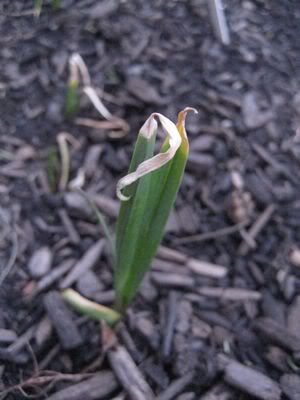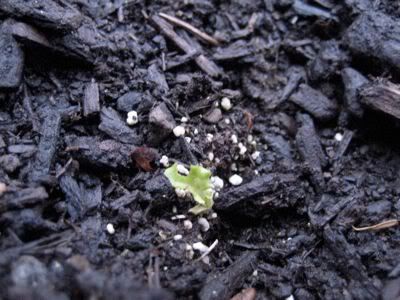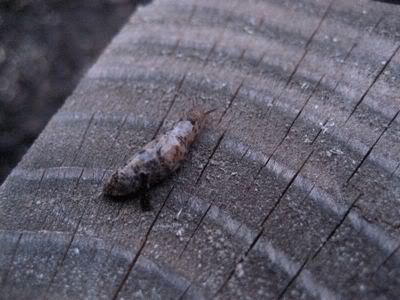I guess that's what I get for just plunking store bought garlic in the garden last year. Turns out my lovely healthy garlic leaves all of a sudden decided to turn to white-ish, brownish, purple-ish mush. Looks like I have a case of Purple Blotch. ::insert menacing music here::
"Purple blotch is a fungal disease that is most common in areas where plants are irrigated and in the South. The spores, which are spread by splashing water, overwinter in crop refuse and germinate in moist conditions.
SOLUTION: Use a fungicide to control this disease. To discourage purple blotch, remove crop debris and avoid growing in wet soil.
*Spray plants with garden sulfer, an organic fungicide, at the first sign of the disease, and repeat according to package directions.
*If sulfer is ineffective, remove the infected plant. At the end of the season, make sure no plant debris, where the spores can overwinter, remains in the garden.
*Discourage the disease by growing future onion family crops in well-drained soil and spacing plants to allow for air circulation.**

So it looks like my garlic was grown "in the South"... how I'm going to keep it dry is a mystery since I live in the PNW and all it ever does here is rain! Looks like I'm going to have to get/make some kind of cloche for them. Also conveniently enough DH was on his way to the hardware store so I rang him up and asked him to pick me up a bottle of Sulfur fungicide. Though he just called and can't find it. Crud. I'll have to go to the nursery tomorrow and see if they have a little jar of it.
Edited on 04/13/09. Annie's Granny had this to say about it (since she's having problems with her store bought overwintered garlic too....)
"Cornmeal Has Powerful Fungicidal Properties in the Garden
Using Cornmeal as an Organic Fungicide
Who would have thought that something as seemingly innocuous as cornmeal would have such potent fungicidal properties? Researchers at Texas A&M Research Station in Stephenville, TX, noticed that a peanut crop planted following a crop of corn didn’t suffer the usual fungus diseases. Further research showed that cornmeal contained beneficial organisms that were at least as effective as common chemical fungicides. Somehow cornmeal is able to attract a member of the Trichoderma fungus family, which is a good fungus that kills off disease causing fungi in a matter of weeks.
Howard Garrett, the Dirt Doctor, has continued the study and finds cornmeal effective on most everything from turf grass to black spot on roses. Furthermore, since it is entirely organic, it can be used on edible crops.
How To Apply
Dry: Work 2 pounds of cornmeal into the soil for every 100 square feet. Water well, to activate the fungus killing properties. One application per season is usually sufficient, but repeat applications won’t hurt anything.
Spray: What’s called ‘cornmeal juice’ can be made by soaking 1 cup of cornmeal in 1 gallon of water overnight. Strain the liquid and use as a spray on susceptible plants.
Cornmeal vs. Horticultural Cornmeal vs. Corn Gluten
Any type of cornmeal can be used as a fungicide.
Food grade cornmeal, found in grocery stores, will work just fine, but it is more expensive and comes in smaller quantities than horticultural cornmeal.
Horticultural cornmeal has not been stored under the stricter guidelines required for food grade cornmeal. Hort cornmeal is general used for livestock feed. It too will work just fine as a fungicide and it comes in bulk.
***Corn Gluten should not be used as a fungicide. Corn Gluten is cornmeal that has been processed to have a higher protein content. Iowa State researchers discovered that cornmeal gluten can inhibit seed germination. It is now used as a pre-emergent weed killer. That’s a great tip, but don’t confuse corn gluten with the fungicidal properties of corn meal.
A final bonus, cornmeal also appears to be a source of nutrients for the soil."
I'm also missing a lettuce start. ::grrrr:: Looks like it was chewed to the nub.

There are no slime trails and nothing really for any little buggies to hide under so I'm not sure. I figure I'll go out and look just as the sunsets or shortly thereafter to see if I can't find the little criminal.
Edited to add: Ah-ha! I found this little guy just moving in on the next start just at sundown. I had to inform him, "No shoes, no shirt, no service". Then I kicked him out.

**Source: The Garden Problem Solver; The Ultimate Troubleshooting Guide for Successful Gardening
1 comment:
I sorry.
:-(
Post a Comment